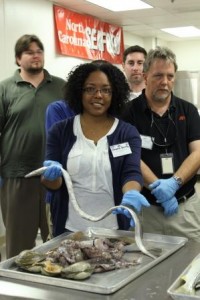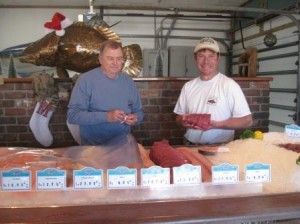By PAM SMITH
The art world prizes provenance — establishing the origins, ownership, custody and safe keeping of works to authenticate their value. The seafood industry focuses on traceability — documenting the origins and handling of seafood products from oceans or farms to processors, suppliers, retailers and food-service providers. This tracking enables fish and shellfish to meet consumers’ expectations of food safety.
Traceability is just one element in a complex network of rules, regulations, standards, guidelines and safeguards that help ensure delivery of the safest possible seafood from water to plate. Considering the amount of seafood consumed by Americans, that’s a tall order. According to the latest calculations by the National Oceanic and Atmospheric Administration, or NOAA, Americans consumed some 4.5 billion pounds of seafood in 2012 — about 14.4 pounds per capita. Despite this, relatively few cases of seafood-related, food-borne illnesses were reported in that same period.
In North Carolina, credit for that good news, in part, goes to the cadre of environmental health specialists who help shield the public from an array of health hazards, says Jeff French, regional environmental health specialist with the N.C. Division of Marine Fisheries’, or DMF’s, Shellfish Sanitation Section.
According to French, when it comes to seafood safety, it’s essential to arm these specialists with a vast array of knowledge. This includes up-to-date “best practices” across the different parts of the seafood industry and the latest regulatory compliance changes.
It’s a lot to keep up with. That’s where the N.C. Environmental Health State of Practice Committee, or SOP Committee, comes in. The SOP Committee was formed in the early 1980s to provide continuing-education opportunities for practicing environmental health specialists, better known as health inspectors.
The late Joyce Taylor, a long-time North Carolina Sea Grant seafood education specialist, helped develop and present early editions of the Seafood Quality and Safety Workshop, working with Wayne Mobley of Shellfish Sanitation.
French, Sea Grant seafood technology and marketing specialist Barry Nash, and Steve Murphey, Shellfish Sanitation environmental health specialist, carry on that important mission as members of the all-volunteer SOP Committee. Each year, they organize a comprehensive three-day course, titled Seafood Quality and Safety Workshop: A Practical Workshop for Environmental Health Specialists, to present timely information on seafood-related topics.
A MOVEABLE FEAST
The curriculum content purposely varies from year to year. “We look for new information, new consumer focus, new products and new experiences to incorporate,” French says.

Workshop participants taste-tested trout burgers from Sunburst Trout Farms. Photo by Vanda Lewis.
The workshop location also changes annually to accommodate the participation of professionals from mountain, piedmont and coastal regions.
A recent SOP workshop drew more than 25 participants to North Carolina State University’s Center for Marine Science and Technology, or CMAST, in Morehead City. Sea Grant and DMF co-sponsored the event.
Participants helped to evaluate a value-added seafood product being developed by Nash and Charles Hudson, research and development chef from Asheville’s Sunburst Trout Farms. The two dished up samples of a trout burger along with an evaluation form calling for comments on taste and texture.
The trout burger could be rolled out this year as the next value-added product in the Sunburst line, Nash says. Data from sensory surveys are an important part of the product-development process, along with profit-point and food-safety considerations.
Nash previously conducted workshops for seafood dealers, processors and regulatory officials in seafood sanitation and Hazard Analysis and Critical Control Point, or HACCP, seafood safety practices. He collaborated with the Seafood Laboratory at CMAST to provide the training.
The U.S. Food and Drug Administration requires all seafood processors to develop and implement a HACCP plan to identify and control food hazards at all critical points in production, he told workshop attendees.
LEARN FROM EXPERTS
French notes that since the earliest years, the hallmark of SOP workshops has been landing seafood safety experts, such as Nash, from agencies, academia and the industry as speakers.
The Morehead City roster included representatives from Darden Foods Group, parent company of Red Lobster, Olive Garden and Longhorn restaurants; Harris Teeter Supermarkets; and Inland Seafood, a major seafood distributor in the Southeast region.
Each company has developed corporate protocols for managing seafood safety. In addition, each contributes to global safety standards as members of the National Fisheries Institute, or NFI. The companies also are represented on NFI’s Better Seafood Board.
NFI is a nonprofit organization dedicated to global seafood safety, sustainability and nutrition. The board focuses on stamping out seafood fraud.
With nearly 30 years in the field, French himself is an expert in finfish and shellfish safety.
Health inspectors can rely on their senses when it comes to finfish, French says. Qualities of fresh fish are:
- Eyes that are clear and not cloudy.
- Whole fish and fillets with firm and shiny flesh. Whole fish should have bright reddish gills.
- A fresh and mild smell, not fishy or like ammonia.
For shellfish, including clams, oysters and mussels, it’s all about knowing their home address. Health inspectors should examine the mandatory information tag attached to the carton or mesh bag. Tags provide dealer name and certification number, harvest date and location, type of shellfish, quantity, and any consumer advisories. Tags must be kept on file for 90 days because they are important for tracing the source of shellfish in the event of illness.
The N.C. Department of Environment and Natural Resources, which includes the Shellfish Sanitation Section, sets strict controls on growing, harvesting and consuming shellfish from pollution-free waters. Some bodies of water are permanently closed to shellfish harvesting.
Others may be closed temporarily after heavy storms. Such restrictions are important because eating raw shellfish, particularly raw oysters, could pose serious health risks for pregnant women, the elderly, young people or people with compromised immune systems, French warns. These filter feeders can harbor Vibrio vulnificus, a bacteria found in warm coastal waters. Consuming Vibrio can lead to nausea, vomiting, diarrhea and stomach pain — and even death in some cases.
TRUTH OR CONSEQUENCES

Charlotte environmental health specialist, Chiante Hamilton, holds a ribbonfish during the Name That Fish workshop. Photo by Vanda Lewis.
Surprisingly, a lurking danger for seafood lovers is not necessarily a bad product, but rather, a bad label, says Shellfish Sanitation’s Murphey.
“A lot of good people spend a lot of time keeping consumers safe from bad seafood products,” Murphey says.
“Unfortunately, there is a lot more seafood fraud than inspectors to go around.”
A 2010 study by Oceana revealed that one-third of 1,000 samples tested were mislabeled — mostly imported products, and mostly lower-value substitutions for more expensive fish. Red snapper is among the most commonly replaced high-value fish, he pointed out to workshop participants.
Most cases of fish fraud involve economic deception, including short weighting, overtreating products or falsifying the origin.
However, some substitutions do pose health concerns. For example, escolar often is fraudulently labeled as white tuna. Eating this species can cause severe, intensive gastrointestinal problems.
Illegal and deceptive practices by some in the industry hurt the legitimate dealer or supplier and undermine consumer confidence, Murphey says.
But sometimes, the perpetrator pays a price. Recently, the Federal Register reported that two importers were found guilty of falsely labeling shrimp. They were barred from importing shrimp — one for five years, the other for three years. The Federal Register is the U.S. Government’s official daily publication that reports legal notice of administrative rules.
The Name that Critter session at the Seafood Safety and Quality Workshop helped familiarize participants with seafood imposters. The photo array also included some exotic, but legitimate, fish that inspectors may encounter in the increasing number of ethnic seafood restaurants and markets across the state.
TAKE-HOME MESSAGE
Alicia Pickett, senior environmental health program specialist for New Hanover County Health Department, praises the SOP annual seafood workshop for helping participants keep up with industry trends and food-code changes at federal, state and local levels.
“I have taken the workshop course twice and come away with renewed confidence in keeping the public safe,” she says.
Like other workshop participants, Pickett shares valuable workshop information with her health department colleagues and encourages them to take advantage of the opportunity to earn continuing education credits. New Hanover County environmental health specialists provide multiple layers of protection in hundreds of food-service settings across the county, including restaurants, schools and markets.
Health inspectors are registered with the state oversight board and are authorized to enforce state rules.
Pickett does not see herself as an adversary when she conducts an unannounced inspection.
“We’re first and foremost educators. We work closely with our eating establishments and markets to ensure owners and managers understand and follow seafood safety code regulations,” she says.
For his part, Johnny Chen is proud to post the near-perfect county health department inspection rating cards in full view of patrons at each of his five eateries in the Wilmington area.
He knows high numerical ratings are good for his restaurants — a business he built slowly as area consumers developed a palette for sushi, and regulators adopted parameters for handling, storing and serving items that may contain raw fish.
Beginning in the 1980s, New Hanover County Health Department also has regulated seafood markets and vehicles that are not regulated by the state, Pickett explains.
County environmental health specialists issue annual permits and conduct unannounced inspections throughout the year to enforce seafood safety compliance. Health inspection rating cards are not issued to seafood markets or vehicles in New Hanover County, but valid permits must be displayed.

Glen Long, owner of Motts Channel Seafood Market, and his manager Thom Franz place freshly cut tuna steaks in a chilled display. Photo by Vanda Lewis.
In other counties, such as Craven, health inspectors issue numerical rating cards to eating establishments and letter-grade cards to seafood market and vehicle operators. These must be displayed along with permits.
Seafood market and vehicle operators may lose their permits if they do not comply with seafood food-code requirements.
Glen Long, Motts Channel Seafood Market owner, prides himself in meeting every benchmark for seafood safety — from a HACCP plan to product traceability and spotless coolers to a picture-perfect, properly chilled fresh seafood display. The New Hanover County seafood market owner says he’s picky and buys only from suppliers whose standards meet his high-quality criteria. For Long, that means no additives and no substitutes.
“If I won’t eat it, I won’t sell it,” Long insists.
Long’s formula for receiving high ratings from inspectors and customers alike is straightforward. He says: “Keep it clean, keep it fresh and keep it cold.” Shellfish Sanitation’s French could not have said it better.
North Carolina Sea Grant has several publications about seafood technology, product safety and marketing. These include:
- Handling Seafood Safely;
- Quality Counts: A Consumer’s Guide to Selecting North Carolina Seafood;
- Branding Seafood: Developing a Marketing Plan to Sell Value-Added Seafood Products; and
- Seafood Traceability: A Practical Guide for the U.S. Industry.
To find these and other documents, go to ncseagrant.ncsu.edu and search for seafood.
*********************************************************************************************************************************
CONSUMER SEAFOOD SAFETY TIPS
Regulation, handling and inspection standards for seafood are meant to ensure that products at the market are safe and fresh.
However, consumers also play a critical role in maintaining seafood safety from point of purchase to the dinner plate.
Mariner’s Menu, North Carolina Sea Grant’s premier seafood resource book by Joyce Taylor, devotes an entire chapter to seafood safety. Here are a few tips to keep in mind when purchasing, storing and preparing seafood: Buy only from reputable sources.
- Buy only fresh seafood that has been properly iced or refrigerated.
- To avoid cross-contamination, do not buy cooked seafood if it is displayed in the same case as raw seafood.
- Transport seafood on ice. Refrigerate or freeze as quickly as possible once home.
- Store fresh fish to be used within three days in the refrigerator on a bed of crushed ice, keeping it as close to 32 F as possible.
- Freeze fresh fish to be used within three to six months.
- Store live clams and mussels in the refrigerator in a shallow pan, allowing for ventilation by covering with a damp cloth or paper towel. Use within two or three days. Discard any that die.
- Cook live crabs and lobsters the day of purchase. Discard any that die.
- Shrimp, scallops and freshly shucked oysters will keep up to seven days on ice in the refrigerator.
- Cooked crabmeat should be used within a week.
- Before handling seafood, wash hands for at least 20 seconds with hot, soapy water.
- Rinse raw seafood under cold, running water to help remove bacteria.
- Do not let raw seafood come in contact with any other raw or cooked food.
- Do not place cooked seafood in the same container that held raw seafood unless it has been washed thoroughly with hot, soapy water.
- Marinate seafood in the refrigerator, not at room temperature. Set aside a portion of marinade for basting or dipping before adding raw seafood. Dispose of marinade that has come in contact with raw seafood.
- Scrub live oysters, clams and mussels with a stiff brush under cold, running water before shucking or cooking.
- Cook seafood thoroughly, 10 minutes per inch of thickness. Add five minutes to total cooking time if fish is cooked in a sauce or wrapped in foil or parchment. Cooked fish should reach an internal temperature of 145 F.
- Oysters in the shell should be steamed four to nine minutes or broiled three to five minutes after gaping. Discard any that do not open.
- Shucked oysters should be fried three minutes at 375 F; broiled three minutes, 3 inches from heat; baked 10 minutes at 450 F; or boiled for three minutes.
- Clams and mussels should be steamed four to nine minutes. Discard any that do not open.
- Thaw frozen seafood overnight in the refrigerator or under cold, running water. Do not thaw seafood at room temperature or with hot or warm water.
- With seafood preparation, as with all foods, cleanliness matters. Wash hands, counters, cutting boards and utensils — as well as anything else that comes in contact with raw seafood — thoroughly with hot soapy water, detergents or antibacterial agents. A tablespoon of bleach mixed with one gallon of water is an effective homemade cleaning solution.
For more information, check out the Mariner’s Menu blog at www.marinersmenu.org. Or look for the book in local stores.
This article was published in the Spring 2014 issue of Coastwatch.
For contact information and reprint requests, visit ncseagrant.ncsu.edu/coastwatch/contact/.
